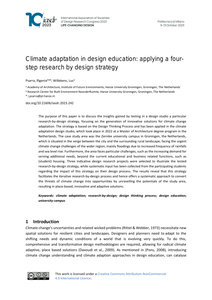The purpose of this paper is to discuss the insights gained by testing in a design studio a particular research-by-design strategy, focusing on the generation of innovative solutions for climate change adaptation. The strategy is based on the Design Thinking Process and has been applied in the climate adaptation design studio, which took place in 2022 at a Master of Architecture degree program in the Netherlands. The case study area was the Zernike university campus in Groningen, the Netherlands, which is situated in the verge between the city and the surrounding rural landscape, facing the urgent climate change challenges of the wider region, mainly floodings due to increased frequency of rainfalls and sea level rise. Furthermore, the area faces particular challenges, such as the increasing demand for serving additional needs, beyond the current educational and business related functions, such as (student) housing. Three indicative design research projects were selected to illustrate the tested research-by-design strategy, while systematic input has been collected from the participating students regarding the impact of this strategy on their design process. The results reveal that this strategy facilitates the iterative research-by-design process and hence offers a systematic approach to convert the threats of climate change into opportunities by unravelling the potentials of the study area, resulting in place-based, innovative and adaptive solutions.
DOCUMENT

Energy poverty is a growing concern in the Netherlands due to the rising gas and electricity prices. There are three main contributors to energy poverty: low income, high fuel costs and energy inefficient homes. Energy poverty effects can have significant consequences, influencing both physical and mental health, increasing the chances of becoming trapped in a cycle of poverty and social isolation. Usually, policy making approaches to combat energy poverty mainly focus on financial support on a household scale or on prices regulating efforts. However, this study argues that actions on a community level could also contribute to alleviating the impacts that energy poverty has on citizens’ lives. For example, community centers in low-income neighborhoods could potentially play a catalyst role in alleviating the effects of energy poverty by exemplifying energy saving techniques, catering to the needs of residents, increasing social cohesion and inspiring collective action. This research explores strategic design interventions through a whole system’s lens; social, energy and nature, that can be applied to the new VanHouten community center in the Oosterpark district of Groningen, the Netherlands. This is a historic, former school building, under a restoration and reuse process, owned by the municipality. Literature reviews, participatory events and interviews have been used to explore the possibilities to mitigate energy poverty, within a research by design process. Beyond the local case, the findings lay the groundwork for more systematic studies on how to alleviate the impact of energy poverty on a community level.
DOCUMENT
Academic design research often fails to contribute to design practice. This dissertation explores how design research collaborations can provide knowledge that design professionals will use in practice. The research shows that design professionals are not addressed as an important audience between the many audiences of collaborative research projects. The research provides insight in the learning process by design professionals in design research collaborations and it identifies opportunities for even more learning. It shows that design professionals can learn about more than designing, but also about application domains or project organization.
DOCUMENT

Het (mee)denken over de toekomst van ons erfgoed is inmiddels een breed maatschappelijk debat. Ideeën over de definities, het behoud en het waarderen van erfgoed veranderen snel. Tijdens hun opleiding ontwikkelen masterstudenten een mening in dit debat in een theorievak (AR1LA061) van de mastertrack Landscape architecture (TUD). In het vervolgvak (AR3LA011) wordt de studentenworkshop ingezet om een locatie specifieke ontwerpvisie te ontwikkelen, als vorm van ‘research-by-design’. Het doel is om studenten lokale vragen te leren uitwerken. Deze locatie specifieke ontwerpvisies leveren na analyse ook nieuwe generieke informatie op, die begeleiders van studentenworkshops nog onvoldoende gebruiken in meer theoretische vragen over het definiëren, waarderen en transformeren van erfgoed. Dit onderzoek wil bijdragen aan het gebruiken van ontwerpvisies voor verbetering van de algemene erfgoedkennis van eigenaren, gemeenten en landschapsarchitectuuropleidingen. Dit onderzoek wil voorzien in handvatten om dergelijke analyses te onderbouwen en zo bij te dragen aan een rijke leeromgeving. Het doel van het voorgestelde onderzoeksproject is om met handvatten te komen hoe de ontwerpvisies van studentenworkshops kunnen worden benut in het verzamelen van kennis over definiëren, waarderen en transformeren van (landschappelijk) erfgoed. Dit onderzoek kent drie pijlers; een literatuurstudie naar dergelijke studentenworkshops in onderwijs (design charettes), een analyses van twee eerdere workshops (op basis van interviews met betrokkenen) en het toepassen van inzichten uit de eerste twee pijlers in een nieuw te organiseren workshop voor het living lab Zuiderwaterlinie in de Landschapstriënnale 2020. De Zuiderwaterlinie is een linie van forten, steden en inundatievelden door heel Noord-Brabant (afbeelding 1). Tegenwoordig is deze militaire verdedigingslinie een drager voor een nieuw te ontwikkelen recreatief en vitaal erfgoedlandschap. Breda heeft vitaliteit als speerpunt aangewezen in City Deals Kennis Maken. In dit onderzoek werkt de TU Delft samen met de gemeente Breda, het projectbureau Zuiderwaterlinie, Staatsbosbeheer en de universiteit Wageningen.